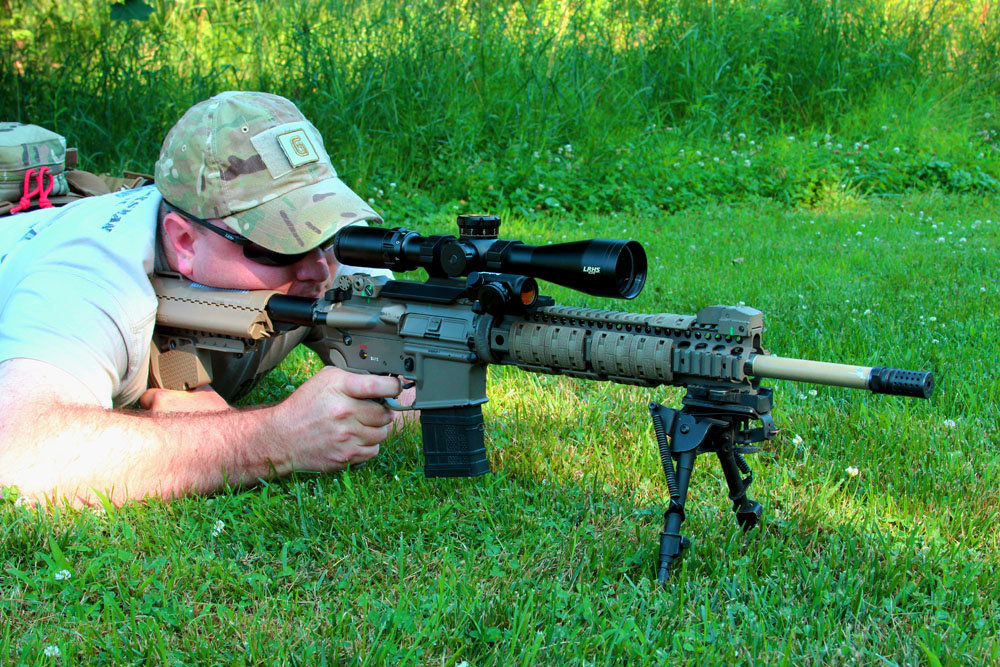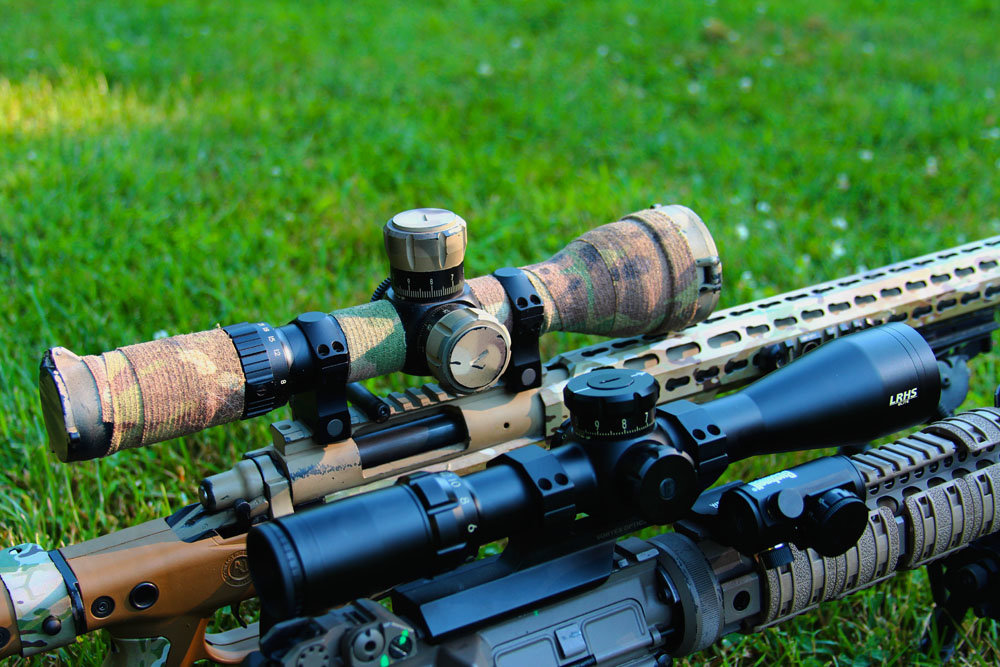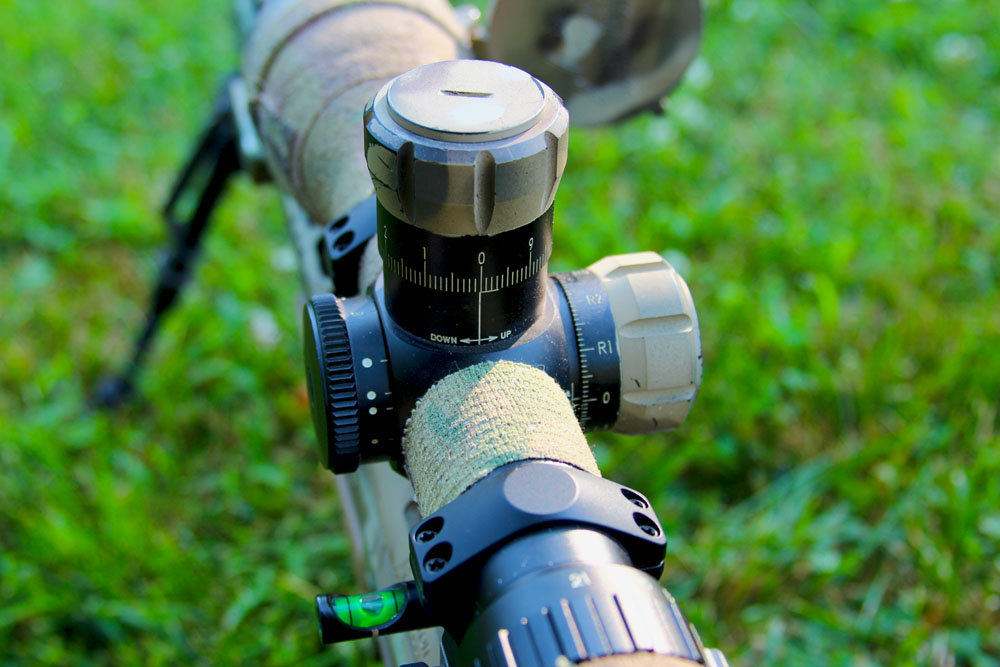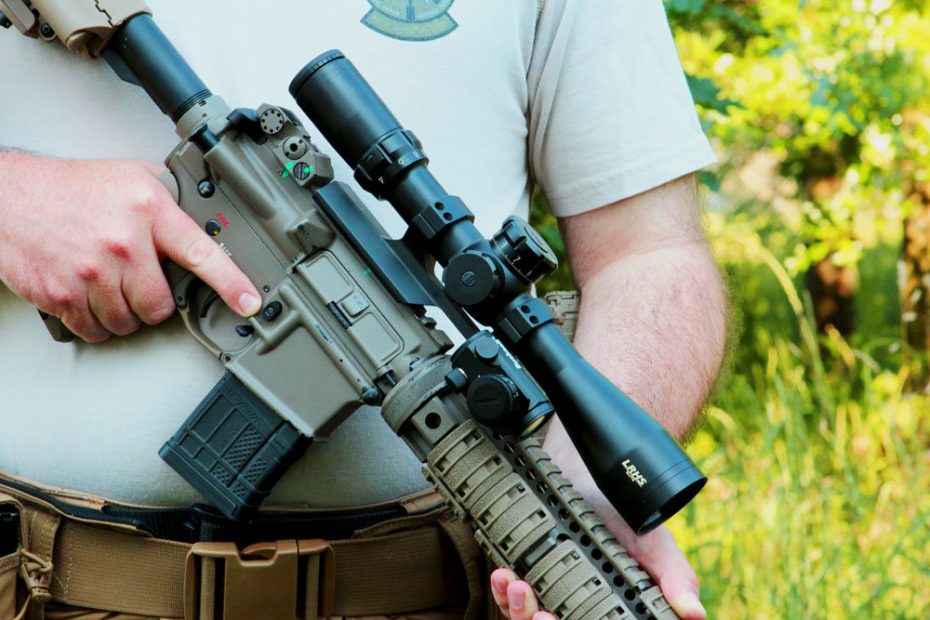[track-link url=”https://www.bushnell.com/all-products/rifle-scopes/elite-tactical-hunter” campaign=”Bushnell LRHS” target=”_blank”]Bushnell LRHS[/track-link]

It wasn’t that long ago that Bushnell optics weren’t well regarded in the tactical/long range shooting community. They were generally thought of as a budget option but not reliable or durable enough for serious hard use on a hunting or duty rifle. Bushnell initiated a paradigm shift when it released the HDMR, a heavy duty tactical rifle scope that was compact and feature laden for a price that was easy to swallow. They have kept that momentum by releasing more tactical optics geared towards competition and precision rifle shooting with everything from red dot sights to high magnification optics. While Bushnell still produces value priced optics, they are no longer looked down upon as a lower tiered option in the tactical precision rifle market. This year Bushnell released a new optic dubbed the Long Range Hunting Scope (LRHS) that looks to set the bar just a little bit higher. While it’s labeled as a “tactical hunter” it has all the right features for a scope that’s meant to go the distance, whether that be on a hunting rifle, semi auto, or precision bolt gun. I was fortunate enough to get one of these scopes for testing and I put it through its paces at the range and in competition.
The LRHS is the result of a close collaboration between Bushnell, George Gardner, and Pat Sinclair to build the best hunting scope possible. George is an avid hunter and competition shooter in addition to owning GA Precision, a custom rifle shop widely regarded as one of the best in the business. Pat is no slouch himself, he’s a professional guide and hunter with decades of experience as well the owner of Montana Rifle Slings. Despite the fact that the Bushnell LRHS is all new the experience behind the design and construction of the scope is certainly evident as well as its shared DNA with its larger cousin the ERS.

From the moment I picked up the LRHS I could tell that this was a field scope, a scope meant to be used and a scope that could take the abuse. The layout and design of the scope is simple, with purpose, and without being too over the top or gregarious. The knobs look like shorter versions of the ones found on the ERS so they are enlarged to make it easy to grasp to make adjustments with gloves on or under stress with sweaty hands. The windage knob is capped but the exposed elevation knob has a great feel to it with 0.1 MRAD clicks that are among the best I’ve ever felt on a Bushnell. They’re crisp, snappy, and very audible so there’s no mistaking where you are on the elevation dial when making adjustments. To further help with that is bigger than average numbers on the knob that only require a glance to know which elevation setting you are on. The elevation knob also features a zero stop that is different from the one found on the ERS and much easier to set comparatively. An innovative feature that was added to the top of the elevation that I haven’t seen elsewhere is a large, forward facing arrow. The idea behind it being is that it gives the shooter a large very obvious indicator if the knob was moved, accidentally or otherwise, off its zero position.

The Bushnell LRHS is a 3-12X variable magnification optic with the reticle placed in the first focal plane. This magnification range strikes a great balance by having enough power for those long distance shots while still being able to dial down for close shots. The first focal plane reticle means that no matter what magnification you are on, the reticle will still be the same size relative to the target for accurate holds for wind and elevation. However, the downside is that for some shooters this means the reticle gets too small and thin at the lower end of the magnification. The 44mm objective and large ocular lens allow for plenty of light transmission and a very generous sight picture. I’m not really one to focus a lot on the image quality of an optic and talk about how good the glass is while ignoring other aspects but this is probably the best Bushnell I’ve looked through. I saw very little chromatic aberration or purple fringing around light colored targets, my view through the optic was crystal clear from edge to edge. The image quality of this scope was easily on the level with some of the bigger names in the industry and the adjustable parallax allowed me to get it just right from 50 yards to infinity.
The reticle in the LRHS is similar to the G2DMR reticle found in the HDMR and ERS scopes but with some changes to make it more suitable for hunting applications. Unbeknownst to some George Gardner actually helped design the G2DMR reticle based on his experiences and also contributed to the G2H’s design along with Pat Sinclair. The G2H reticle’s most prominent feature is the large 4 mrad “circle of death” around the cross-hairs for fast reticle target alignment, even on the lowest power setting. The reticle still features the familiar “Christmas tree” below the cross-hairs for accurate elevation and windage hold overs without the need to dial any of the knobs. This is perfect for those situations where there is little time for dialing or if the first shot was just slightly off target and a fast correction can be made using just the reticle. The G2H is mil based just like the G2DMR so it maintains familiarity and matches up perfectly to the adjustments on the knobs to make everything simple from zeroing to dialing in corrections. This make create a learning curve for some shooters that are used to MOA adjustments but once learned it’s an easy system to use and adapt to different calibers. The reticle is also non-illuminated which might be a negative for some shooters but for most I believe it will be a non-issue.

To test this scope out I threw it on the AR-15 that I use for DMR competitions as a companion to its larger cousin, the Bushnell ERS that I use for long range shooting. Peacemaker National Training Center holds monthly Long Range Challenge and DMR matches back to back that made the perfect testing ground for this optic. First though I had to take a quick trip to PNTC’s Independence and Patriot Ranges to zero and check tracking.
Getting the rifle zeroed was easy enough and it was as simple as seeing where my rounds impacted on the target and using the reticle to measure the amount of correction I had to dial in. I really like the new zero stop mechanism that Bushnell is using for this scope as it’s much easier to set than the one in the ERS. To set it all that is needed is 5/64th wrench to loosen the three set screws and turn the larger clutch disk down until it hits the dead stop. Simply tighten the set screws, replace the elevation knob and you’re done, the zero stop is set. On a flat top AR-15 I was pleasantly surprised to find that I had just over 13 mils of elevation available, which is really very good for a scope with a 30mm tube and plenty of elevation for a little carbine such as mine. I spent the rest of the day shooting steel at 200, 300, and 600 yards using the same Mk 262 ammunition that I use in competition, a 77 grain SMK leaving the muzzle at about 2,650 fps. I have very good drop data for this ammunition out of my rifle and dialing the same elevation adjustments into the LRHS yielded solid hits at each distanced so I was confident the scope was tracking right.

The DMR match at PNTC is set up as four stages with multiple targets on each stage that are usually engaged from various positions, whether that be sitting, kneeling, prone, or off of a barricade. The ranges usually top out at about 600 yards and while that isn’t much for some long range cartridges, for a .223 rifle that can be a fair stretch depending on the ammo. What I enjoy about these matches though is that they combine odd positions with short time limits to hit targets multiple times for score so the equipment has to be set up right and the shooter has to know their dope. The LRHS turned out to be well suited to the task of operating on a DMR rifle with its generous sight picture and eye relief I found that I didn’t have to be perfectly behind the scope every time. If I was a little off because of the position I could still see a nice, bright, clear image to use to engage the targets. The extra magnification helped to also spot my misses and make corrections while it was reassuring to know that the first focal plane reticle was always accurate if I had to ratchet back the power. I rang plenty of steel that day but sadly not as much as I had hoped but I can’t blame the equipment at all, the scope performed flawlessly and was well received by those that looked through it.

A few weeks later I found myself on my way to Ohio to shoot with a close relative on the family farm and stretch the legs on the LRHS once again. We didn’t have the whole run of the farm but enough to set up a nice 300 yard range with steel and cardboard targets. From the top of the hill it was almost right at 300 yards to the 66% IPSC targets I had set up, an easy shot with this combo. After getting my dope dialed in I easily stacked five rounds on top of each other on the high center chest portion of the target. From there I just sort of played around and decided to start putting them in the head portion of the target. I felt the reticle was right inside the “Goldilocks zone” for reticles where it was just the right thickness to quarter the target nicely while not covering too much of it up, this is sometimes an issue with FFP reticles. The head on the 66% IPSC is about 6” and I was putting one right after the other in a cluster that was probably about 3” across. I let my relative get down behind the gun to send a few rounds down range and although he’s never really shot anything beyond 100 yards he was ringing steel and making small groups of his own using the LRHS in no time. The optical quality also allowed him to see his own hits on the steel and although inexperienced at shooting that far he kept nearly all of his shots in the chest area of the target.

After using the Bushnell LRHS for several weeks I’ve determined that I definitely want this scope for my own. The feature set on this scope makes it a little different for the average hunting rifle but they would all be familiar to someone that does any kind of long range hunting or shooting. Of course all of those features, like the mil-based reticle, zero stop knobs, adjustable parallax, and variable magnification make it a very versatile package that can be used for a wide variety of platforms and applications. Law enforcement marksmen could certainly make use of the scope’s first focal plane reticle and zero stop turrets for situations when adjustments have to be sometimes be made quickly on the fly. The scopes’s magnification range and size also lends itself well to a precision AR-15 or AR-10 platform when used with a cantilever mount. With the addition of an offset red dot sight there wouldn’t be a target from point blank to the maximum effective range of the cartridge that couldn’t be accurately engaged with this type of set up. With an MSPR of $1,499, Bushnell has this scope set up to compete directly with some of the largest names in the industry and to be honest I think I’d pick this scope over most others every time. Additionally, the scope is covered by Bushnell’s Bullet Proof Warranty meaning that it can be returned for a full refund within one year of purchase for whatever reason with no questions asked.

Bushnell ERS
The Bushnell ERS was my first exposure to the higher end Bushnell scopes prior to the LRHS and after using it for over a year on my Remington 700 AAC-SD I have complete confidence in this scope. The Bushnell ERS is an upgraded version of the original HDMR scopes and a big cousin to the LRHS with similar features and a design tailor made for precision rifle shooting at long range. My confidence is bolstered by the large number of Bushnell DMR and ERS scopes used by professional law enforcement and military shooters as well as some of the best competition shooters in the country.
The Bushnell ERS has everything that a good long range scope should, it has good glass, good knobs that are audible and tactile, and adjustments that match the reticle for easy corrections. Just like the HDMR it is a 3.5-21 times magnification scope with a 34mm tube to provide plenty of elevation to get just about any cartridge well past 1000 yards. The elevation knob is what really sets the ERS apart from the HDMR in that it is both locking and features a zero stop to ensure that the shooter will never lose track of the scope’s zero. Unlocking the turret is simple, just lift up on the knob to start making adjustments and to lock it back all that is required is to push the knob back down. The zero stop is pretty easy to set and feels good when you hit the hard stop letting you know that you’ve returned to your zero point. Unlike the LRHS the windage knob on the ERS is not covered but does lock and unlock in the same manner as the elevation knob to prevent unwanted adjustments. As any good long range scope should the ERS also has a side focus parallax knob to give the shooter nice, crisp images from 50 yards to infinity. The parallax knob does not feature any distance markings though but I would not consider this a downside as most of the time the ranges listed on a parallax knob aren’t even close to the actual ranges.

The reticle in the ERS is G2DMR, a reticle that the G2H was based on and as mentioned previously it came about as a result of a collaboration between Bushnell and George Gardner. While some people are fans of more traditional reticles like the standard Mildot, enhanced reticles like the G2DMR have surged in popularity because of the versatility that they offer. Placed in the first focal plane it is always accurate, whether that be high power, low power, or somewhere in between and the extended portion below the crosshairs aids in elevation and wind holds. An interesting feature of the reticle is that the thicker portions of the reticle are actually broken down into 0.1 mrad increments to help make very accurate readings for range estimation. Traditional range estimation techniques that use the graduated reticle in the scope are becoming something of a lost art, but some competitions still like to ban the use of laser rangefinders to up the ante so to speak. So having a reticle that can range accurately at any power and be broken down into very fine increments can mean the difference between a hit or a miss, dropped points or another trophy for the mantle.
I have been fortunate in that I have places near me that offer a fair bit of distance to really stretch the limits of my Remington 700 AAC-SD. I’ve used this combination for many of the Long Range Challenges at Peacemaker National Training Center for the past year and it has yet to disappoint me. These matches typically have targets that go out to beyond 1000 yards with targets that can get pretty small so having the right scope is essential. The last match I was at had a target at 400 yards that was barely 1 MOA wide and blended in almost perfectly with the background. The ERS’s exceptional glass and 21 power top end coupled with the G2DMR reticle helped pick the target against a brown hillside and get a hit on target with plenty of time on the clock. While this scope has very good image quality it isn’t perfect and some may notice some purple chromatic aberration around very lightly colored targets if they have an improper cheek weld. However, that condition can be created with nearly any optic so it’s not necessarily a slight towards the Bushnell product, only an observation. For me when I dialed the ERS down to 15X and compared the image side by side to my Nightforce 3.5-15X F1 I could not discern any real difference in the image quality between the two. I have run both scopes in competition and lately I’ve been finding myself grabbing the gun with the ERS on it more and more because of the increased magnification and reticle.

In the time that I’ve been using the ERS I’ve been quite impressed by its toughness and repeatability. Since mounting it back up on my Remington 700 AAC-SD using taller rings to clear the AI AX chassis I’ve had to re-zero it a grand total of zero times. While I don’t want to come off as clumsy I’ve knocked the scope over, banged it around, and committed what some might call scope abuse but I know I can count on it to put the rounds where I want them. That is truly a level of confidence that you can’t put a price tag on and is probably one reason that this scope and its other iterations are in such wide spread use. Although this particular Bushnell ERS was my first and I doubt it will be my last, perhaps the FDE one will be in my future.
As I look at these two scopes and reflect back on my using them I believe that the Bushnell tactical scopes fare so well against many of its competitors because it offers a lot of bang for the buck. Today’s consumer is always looking for the best deal and in that regard Bushnell certainly delivers by providing scopes with great optical quality, repeatable adjustments, and versatile reticles at a price that most can live with. The prices for some high end scopes are starting to hit stratospheric levels with some tactical scopes costing nearly $4,000 or more. To that end the Bushnell ERS and LRHS are down right reasonable options with street prices under $2,000 while still providing excellent performance. I look for the Bushnell Tactical line to only get better when you look at how far they have come in the past few years starting with the HDMR, then the ERS, and now the LHRS.
[one_half]

[/one_half]
[one_half_last]

[/one_half_last]
[one_half]

[/one_half]
[one_half_last]

[/one_half_last]
